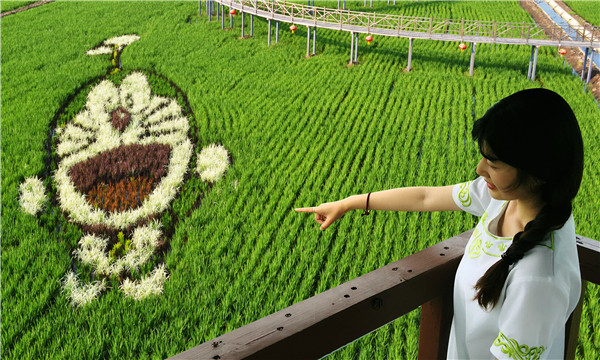Agri-tourism booms as colorful concepts crop up across the region
 |
|
A tourist in Shenyang admires Tanbo farm art of Doraemon that portrays a magical cat character from a Japanese manga series. LIU DONG/CHINA DAILY |
One of the granaries and golden corn belts of the country, Shenyang, capital of Northeast China's Liaoning province, is transforming into an agricultural tourism destination.
According to the Shenyang Committee of Rural Economy, agri-tourism is expanding rapidly. Last year, 195 new hospitality projects were approved. Their income reached 908 million yuan ($136 million) from over 4.4 million visitors.
"Owing to the speeding up of urbanization and improvement of living standards, people's consumption patterns have changed. The rising middle class are especially more willing to pay for leisure tours," said Shao Jianbing, a professor of economics at Liaoning University.
His view finds an echo in McKinsey & Company's research.
According to its latest study, China's middle class consumers spend significantly more time and money on leisure activities and tourism. Moreover, they prefer to choose tours that afford memorable experiences, not just sightseeing opportunities.
In this context, agri-tourism offers many opportunities for such experience-seeking travelers.
Shenyang Xibolongdi Innovative Agri-Business Co Ltd is one of the beneficiaries of this trend. The firm's general manager, Zhao Aijun, is a resident of Shenyang. Sensing opportunities in agri-tourism, he began to develop paddy field tours and Tanbo art in Shenbei district, the agriculture development zone of Shenyang in 2012.
Tanbo is a form of rice paddy art with origins in Japan: farmers plant varieties of rice paddies with different colors, which grow up and create magnificent giant organic pictures in paddy fields.
"At first, we just wanted to popularize our rice products by developing paddy field tours. Tanbo art is part of a strategy to attract more travelers. Surprisingly, people like it very much," he said.
In the past three years, the number of visitors to Xibolongdi's farms has more than tripled from 15,000 to over 50,000. Last year's revenue from tourism reached 5 million yuan, accounting for about 30 percent of the total.
Some 17 images were displayed in the rice fields covering an area of 13.33 hectares in Zhao's manor.
"It's a good choice for family outings. It offers a quiet, picturesque, scenic place to relax. What's more, it's not too far from downtown," said Li Haoyu, a visitor.
"Leisure farming is a trend and helps restructure and innovate patterns in economic activity, especially agricultural production," said Zhang Junhua, vice-director of the Shenyang Committee of Rural Economy.
According to the data of the Ministry of Agriculture, nationwide revenue from agri-tourism reached 440 billion yuan in 2015, up 10 percent year-on-year. About 5.5 million rural families benefited from the development.
Contact the writer at liuce@chinadaily.com.cn














